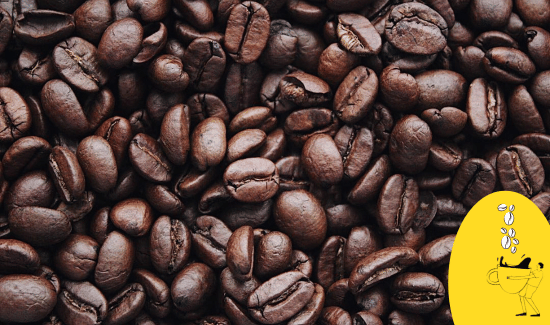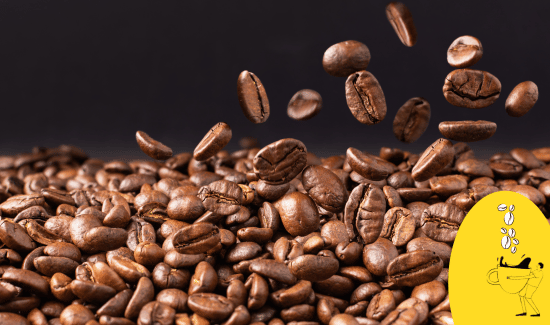
The topic of oily coffee beans is one that frequently draws the interest of people who are passionate about coffee. These beans have a distinct appearance that distinguishes them apart from their counterparts that do not contain oil since they are shiny and glossy. It is essential to have an understanding of the factors that contribute to the presence of oiliness, despite the fact that some people may confuse oiliness with freshness or quality.
In this blog post, we’ll explore the intriguing world of oily coffee beans – what sets them apart, how to identify them, and whether they make a difference in your brewing experience.

Why are coffee beans oily?
One of the factors that contribute to oily coffee beans is the roasting process. Darker roasted coffees tend to be more oily compared to lighter roasts. The longer and hotter the roast, the more oils are released from within the bean.
Another factor is the type of bean itself. Certain varieties such as Arabica beans are known for being less oily compared to Robusta beans. This doesn’t mean one is superior to the other; it simply reflects their inherent characteristics.
So how can you tell if your coffee beans are oily? One way is by looking at them closely. Oily coffee beans will have a glossy sheen on their surface, almost like they’ve been coated in a thin layer of oil. You might even notice small droplets or patches of oil when examining them up close.
It’s worth noting that while oils on coffee beans can enhance flavor and aroma, excessive oiliness could also indicate staleness or poor storage conditions. It’s always best to purchase freshly roasted whole bean coffees from reputable sources and store them properly in an airtight container away from light, heat, and moisture.
Oily coffee beans are not necessarily better or worse than non-oily ones – it all comes down to personal preference and brewing methods. Whether you prefer the rich flavors imparted by oils or opt for a cleaner cup with minimal residue is entirely up to you!

Non-Oily Coffee Beans
In this section, we’ll explore the characteristics of non-oily coffee beans and why they might be a great choice for your brewing needs.
One of the key distinctions between non-oily and oily coffee beans lies in their appearance. Non-oily coffee beans tend to have a drier surface compared to their oily counterparts. This is because the oils present in the bean remain inside rather than being released onto the surface during roasting.
The lack of oil on the surface may also impact flavor profiles. Non-oily coffee beans often result in a cleaner and brighter cup with more prominent acidity. If you enjoy fruity or floral notes in your brew, opting for non-oily beans might be a good idea.
Additionally, non-oily coffee beans can offer greater versatility when it comes to brewing methods. The absence of oil means that these beans are less likely to clog up grinders or espresso machines, making them suitable for various equipment types.
It’s worth noting that just because a coffee bean is labeled as “non-oily” doesn’t mean it lacks any oils altogether. These oils are simply contained within the structure of the bean itself rather than being visibly present on its surface.
So next time you’re shopping for some new coffee beans, consider giving non-oil ones a try! You might discover exciting flavors and find them easier to work with depending on your brewing preferences.

How to tell if your coffee beans are oily
Are you curious to know if your coffee beans are oily? Well, there are a few visual and tactile cues that can give you a clue. First off, take a close look at the beans themselves. Oily coffee beans tend to have a glossy appearance, almost as if they’ve been coated in a thin layer of oil. This shine is due to the natural oils present in the beans.
Next, try touching the beans with your fingertips. If they feel slick or greasy to the touch, chances are they are indeed oily coffee beans. The presence of these oils affects both the texture and flavor of your brew.
How your grinder treats these beans is another sign that they are fake. Oily coffee beans tend to be stickier than non-oily ones, which can cause some grinders to get clogged or clump together.
When brewing your coffee, take note of any residue left behind on your equipment after use. Oily coffee beans often leave more residue than non-oily ones.
By paying attention to these indicators – appearance, texture, grinder performance and residue – you’ll be able to determine if your coffee beans are indeed oily or not.
Conclusion
Oily coffee beans may be preferred by some individuals who enjoy a richer taste and aroma in their brews. On the other hand, non-oily beans are often chosen for their cleaner profile and ability to preserve flavors over time. In the end, the choice between oily and non-oily coffee beans comes down to what you like. There is no right or wrong answer. You can like a smooth taste or a crisp finish. The key is to try out different kinds and figure out which ones you like best. So go ahead and drink your best coffee, no matter how much oil it has in it.
FAQs About Oily Coffee Beans
1. Are oily coffee beans better in taste?
The oil on the surface of coffee beans does not necessarily indicate superior flavor. It is a matter of personal preference whether you enjoy the richness and intensity that oily beans can bring to your cup of joe.
2. Can I use oily coffee beans in any brewing method?
Yes, you can use oily coffee beans in various brewing methods such as espresso machines, French press, and drip brewers. However, it is important to note that certain brewing methods may require adjustments due to the potential for clogging or uneven extraction caused by oils.
3. Do all dark roasted coffee beans become oily?
Not every oily surface will form on dark-roasted coffee beans. Some roasters may choose to cook their beans for longer, but not long enough for the oils to come to the surface.
4. How should I store my oily coffee beans?
To maintain freshness, it is recommended to store your oily coffee beans in an airtight container away from light, heat, and moisture. This will help preserve their flavors and aromas for a longer period.
5. Should I avoid buying pre-ground oily coffee?
It is generally advised to grind your own whole bean coffees as soon as possible before brewing for optimal flavor retention. However, if you prefer convenience or do not have access to a grinder, purchasing pre-ground oily coffees can still provide a flavorful cup of java.

As a dedicated blogger, I share insights, tips, and knowledge on all things caffeinated and beyond. I firmly believe that a well-brewed cup of coffee or a skillfully crafted cocktail has the power to unite people and ignite engaging conversations.



